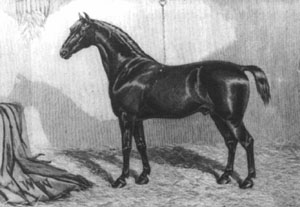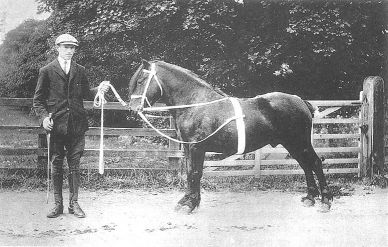Turn of 19th-20th Century
Wilson ponies
Christopher Wyndham Wilson of Rigmaden, Kirkby Lonsdale (a grandson of that Christopher Wilson who owned a "turf pony") decided in the 1870s to breed a new type of pony, or possibly to reinvent the old type that his grandfather had used.
His choice of foundation sire was "Sir George", foaled 1866, who was a brown stallion under 14 hands that traced back to Norfolk Roadster stock, and was at least partly Thoroughbred.
Sir George was very highly regarded, as he won at 8 successive shows of the Royal Agricultural Society before Wilson bought him. (An RAS show was held in Carlisle in 1880 and C W Wilson swept the board in the pony stallion class with home bred ponies - 1st, 2nd, 3rd and reserve champion - notably, with Little Wonder, a son of Sir George.) At Penrith Show in 1890, the organisers made Mr Wilson a judge for the Harness classes which may have opened up the competition to other owners!

On the right is a contemporary illustration of Sir George, c. 1880, taken from an agricultural review. Mr Wilson's initials can be seen on the rug in the left hand corner of the picture.
Fells as foundation stock
Initially at least, Wilson bred Sir George to Fell mares. He chose small mares because he wished to breed animals of pony type rather than horse type. Probably they were brown or dark bay. Wilson also used small Welsh mares in the same way. He turned the youngstock out to the fell to keep their height down. The fillies of this cross were put back to Sir George for three generations, which must have stamped the type very strongly. Most of the stock got by Sir George were bay, around 13.2, with hardly any white markings.
Local tradesmen bought the ones that Wilson considered too tall, or otherwise not good enough to keep. Jonty Wilson, who was a blacksmith in Kirkby Lonsdale (though unrelated to C W "Kit" Wilson), wrote that the town's show class for the tradesman's driving turnout was one of the highest quality in the country.
Kit Wilson sold out once he had achieved his goal, perhaps foreseeing the impact that the internal combustion engine was to have on transport, but the "Wilson pony" type continued to prove popular.
The Wilson pony was written about as a type in 1905, and went on to be a part foundation of the Hackney Pony.
A photographic puzzle
This photograph was published in F W Garnett's "Westmorland Agriculture 1800-1900" dated 1910.
Mr Garnett, president of the Royal College of Veterinary Surgeons, was a major force in the setting up of the Fell Pony Society. He worked towards it from 1903 until 1912, when he and Lord Lonsdale presided over the newly formed northern committee which dealt with Fell registrations. He was secretary to this committee for another 4 years and when in 1918 the Fell Pony Society was formed, his office was transferred to that also.
According to Garnett, this is also “Sir George.” He says the pony was owned by Wilson, but gives Wilson's address as Oxenholme, Kendal, rather than Rigmaden, Kirkby Lonsdale.

Photo of Heather Boy (600 Fell) courtesy of Cumberland and Westmorland Herald, Penrith.
The puzzle arose because the location, handler and all the background shown here are duplicated in another photo. That other photograph is in Iona FitzGerald's book "Dales Ponies". The author tells me it was obtained from Beamish Open Air Museum, and it undoubtedly shows the same pony, with its mane falling to the right, wearing identical tack, but facing the opposite way. From discussion of that photo with older Dales breeders who knew him, she names the man with confidence as the Dales breeder, J W Dalton of Snowhope, Co Durham, who was a founder member and later president of the Dales Improvement Society; and the pony is most probably the Fell stallion, Heather Boy (600 Fell; foaled 1905, by Heather's Model x Fanny). Heather Boy was brown, with a small star. His registration gives his height as 13.3 hh, measured in 1912. Yes, Mr Dalton - who was around 18 years old at the time this photo was taken - was very tall.
This pony looks to have much more Fell blood than Hackney, anyway. He is much more likely to be Heather Boy than the original Sir George, who would have achieved the phenomenal age of 44 in 1910. He is evidently in his prime, which fits with the likely age of Heather Boy (5 years). Seeing that there are other errors about the caption in Garnett, I am inclined to think Mrs Fitzgerald has the right information.
In defence of Frank Garnett's photo caption error, the name "Sir George" can be found in the Fell Stud Book right up to 1904. The name of Kit Wilson's foundation stallion was very popular; whether these entries were all actually by the same horse is another puzzle. Compare these Stud Book entries:
Vol VIII 1515 Spite foaled 1898; by Sir George, chestnut
Vol X 2232 Diamond III foaled 1899; by Sir George 13.2, brown
Vol XIV 2271 Mountain Lass III foaled 1904; by Sir George 13.2, brown
There were certainly some mares registered in the Stud Book who were granddaughters of the original Sir George. And Heather's Model 381 (sire of Heather Boy) was a great grandson of Sir George on his dam's side! Perhaps this is where the error crept in.
... to foster and keep pure the old breed...
The "Fell Pony Committee" in 1912 began to promote the breeding of high class riding and driving ponies under the auspices of the National Pony Society. Comments were made about Fell pony breeders having to avoid the temptation to breed a Wilson pony instead of the tough, uncrossed native type. The existence of the Wilson pony may have been one of the spurs that prompted the aim "to foster and keep pure the old breed of pony that has roamed the fells for centuries". It is probably also true to say that it was recognised that by keeping the local strain relatively pure there was always going to be a tough foundation stock from which the "flying machines" could be bred if they were wanted.
Another threat to the pure-bred Fells was the need for a larger and stronger agricultural horse. Cross-breeding had caused the extinction of the Scottish Galloway, which was absorbed into the Clydesdale breed in the early 19th Century. In the following decades this was as much of a problem as the breeding of the hackney types.